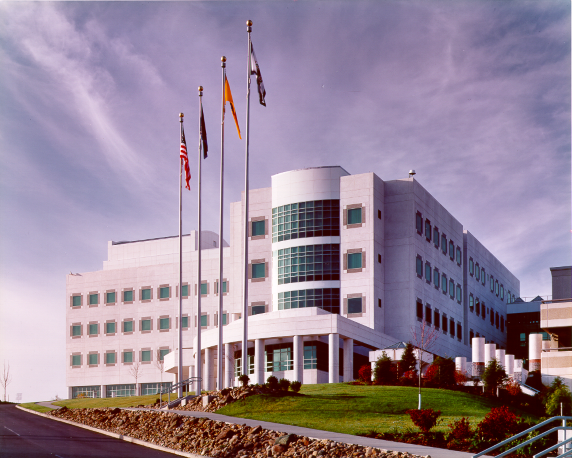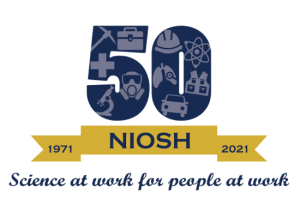NIOSH “L” Building Marks 25 Years of Innovative Research
Posted on by During this year commemorating the NIOSH 50th anniversary, another family milestone is approaching. October 19 marks the 25th anniversary of a close, though lesser-known, NIOSH relative: a building on the Morgantown, West Virginia campus.
During this year commemorating the NIOSH 50th anniversary, another family milestone is approaching. October 19 marks the 25th anniversary of a close, though lesser-known, NIOSH relative: a building on the Morgantown, West Virginia campus.
At its inception in 1996, the “L” building, so-called due to its resemblance to that particular letter, was groundbreaking, literally and figuratively, in the field of occupational safety and health research. With 167,000 square feet of laboratory space stocked with the latest scientific equipment, the L building created hundreds of new jobs when it joined the original NIOSH “H” building—again, so-called due to its alphabetic contours—built in 1971 [1]. Importantly, the L building facilitated a major expansion of NIOSH research from epidemiological studies, or the frequency and causes of work-related illness and injury, to basic research of the biological processes that occur in response to workplace hazards. Today, this expansion continues to advance our understanding of workplace safety and health.
Health Effects Laboratory Division: Improving Worker Safety and Health Through Early Response Research
One of the L building’s first residents was the newly established NIOSH Health Effects Laboratory Division, or HELD. In this critical division, engineers and other scientists apply expertise in immunology, allergy, and inflammation to study some of the earliest responses, often at the level of the cell, to workplace safety and health hazards. Their goal is to control and prevent the effects of these hazards well before they can cause injury or illness to workers. HELD’s recent advances are too extensive to list but range from preventing airborne contaminants in the workplace to preventing nerve damage from power tools. The following are a few examples [2]:
Acoustic Particle Generation System
The acoustic particle generation system is based on a NIOSH-patented technology. Using this advanced technology, scientists investigate the health effects of work-related dusts and nanoparticles, which are so minute that they cannot be seen without specialized microscopes.
Finger Adapter Method
This method evaluates finger protection for workers using vibration-reducing gloves. These special gloves are used to protect workers from hand-transmitted vibration exposure, which can increase the risk for nerve damage when using power hand tools.
Personal Bioaerosol Cyclone Sampler
This licensed technology collects airborne particles from the environment in the appropriate laboratory tubes to facilitate analysis. Worldwide, institutions have used this technology to improve occupational health and safety. In the United States, for example, the University of Cincinnati collected airborne mold in water-damaged buildings in New Orleans and the California Institute of Technology collected pollen and pollen fragments. West Virginia University and NIOSH collected airborne influenza virus in a hospital emergency department and NIOSH scientists collected airborne mold in public schools and dust in a processing facility. Internationally, the Norwegian National Institute of Occupational Health collected dust at grain-handling facilities [3].
In addition to providing a scientifically advanced new home for HELD, the L building provided laboratory space and equipment to three other NIOSH divisions, greatly expanding their research capabilities. These divisions are the Division of Safety Research (DSR), the Respiratory Health Division (RHD), and the National Personal Protective Technology Laboratory (NPPTL).
Division of Safety Research: Improving Worker Safety and Health Through Traumatic Injury Research
The focal point for traumatic injury research at NIOSH, DSR seeks to identify, reduce, and prevent work-related injuries and deaths across all industries [4]. With the opening of the L building, DSR obtained critical laboratory space and equipment that enabled scientists to study and improve fall prevention methods and, thereby, advance worker protection.
An example is the NIOSH-developed Ladder Safety App, an award-winning mobile app designed to prevent injuries from falls. This free app provides tools and information to enable workers and others to correctly set up and use extension and step ladders, whether within the workplace or in other situations.
NIOSH scientists also use the L building’s laboratories to study improvements to ambulance design to prevent injury in the event of a crash. In 2017, this research led to the development of the educational video series Improving EMS Safety Through Ambulance Design. The seven-part series, funded by NIOSH and the Department of Homeland Security’s Science and Technology Directorate, provides information about new crash test methods and recent changes in ambulance design, testing, and manufacturing to improve safety for workers and patients.
Respiratory Health Division: Improving Worker Safety and Health Through Respiratory Research
RHD scientists study how to prevent work-related respiratory disease caused by hazardous materials in the workplace. A central component of RHD’s research is asbestosis and coal workers’ pneumoconiosis, or black lung disease. Caused by inhaling excessive amounts of coal dust, black lung disease has more than doubled in rate over the past 15 years and is increasingly occurring among younger miners. Putting research into practice, RHD developed a video series to raise awareness of black lung disease and how to prevent it. In 2020, NIOSH released the Faces of Black Lung II – The Story Continues as a follow-up to the first video in the series, called the Faces of Black Lung. RHD also shares its research findings through a database, the Work-Related Disease Surveillance System, which provides invaluable information on work-related respiratory diseases [5].
When the L building opened in 1996, NIOSH scientists in RHD benefitted from specialized laboratory space and equipment designed to simulate real-world workplaces. An example of recent equipment is a specially designed test chamber, which scientists use to measure small particles emitted from a desktop 3D printer. Their results show that the printer releases high amounts of hazardous particles into the air during printing, underscoring the importance of workplace controls to prevent accidental inhalation of these particles [6].
National Personal Protective Technology Laboratory: Improving Worker Safety and Health Through Personal Protective Technologies
NPPTL prevents work-related injury, illness, and death by advancing personal protective technologies (PPT). Its research helps protect more than 20 million U.S. workers who rely on this equipment, including respirators, clothing, gowns, gloves, eye protection, and other equipment. Through laboratory and field research, and other activities, NPPTL’s work includes respirator approval and evaluation programs to improve the correct and effective use of PPT.
Respirator Fit and Approval
Integral to NPPTL’s efforts is respirator fit testing. The L building’s virtual-simulation laboratories enable scientists to replicate actual workplaces to test respirator fit and ensure the highest degree of protection. These efforts became critical early in the COVID-19 pandemic with widespread shortages of the most common type of respirator used by healthcare workers, the N95. At that time, the NIOSH respirator testing program helped lay the groundwork for the Food and Drug Administration’s Emergency Use Authorization, which increased respirator availability by allowing the use of other NIOSH-approved respirators, such as elastomeric and powered air purifying, in addition to the N95 [7].
In addition to testing, NPPTL manages the Respirator Approval Program for devices used in the workplace. Each respirator model must meet certain federal performance requirements (42 CFR 84), which specify a minimum level of protection from airborne hazards.
NIOSH Continues its Legacy of Occupational Safety and Health Research
On its 25th anniversary, the L building continues to provide the vital laboratory space and specialized equipment that scientists need to achieve the NIOSH vision of “Safer, Healthier Workers,” throughout the country and internationally. Please join us as we celebrate this milestone and look forward to another quarter century of scientific achievements in the L building’s laboratories.
Anne Blank, MS, is a health communication specialist in the NIOSH Office of Health  Communication and Research to Practice.
Communication and Research to Practice.
This blog is part of a series for the NIOSH 50th Anniversary. Stay up to date on how we’re celebrating NIOSH’s 50th Anniversary on our website.
References
- NIOSH Science Blog | NIOSH’s State-of-the-Art Facility in Morgantown Celebrates 20 Years, October 13, 2016.
- NIOSH [2019]. Health Effects Laboratory Division. Cincinnati, OH: Department of Health and Human Services, Centers for Disease Control and Prevention, National Institute for Occupational Safety and Health, DHHS (NIOSH) Publication 2019-134.
- NIOSH | Aerosols
- NIOSH [2018]. Division of Safety Research. Morgantown, WV: U.S. Department of Health and Human Services, Public Health Service, Centers for Disease Control and Prevention, National Institute for Occupational Safety and Health, DHHS (NIOSH) Publication No. 2018-138.
- NIOSH [2018]. Respiratory Health Division (RHD). Morgantown, WV: U.S. Department of Health and Human Services, Public Health Service, Centers for Disease Control and Prevention, National Institute for Occupational Safety and Health, DHHS (NIOSH) Publication No. 2018-142.
- Jinghai Yi, Ryan F. LeBouf, Matthew G. Duling, Timothy Nurkiewicz, Bean T. Chen, Diane Schwegler-Berry, M. Abbas Virji & Aleksandr B. Stefaniak(2016) Emission of particulate matter from a desktop three-dimensional (3D) printer, Journal of Toxicology and Environmental Health, Part A, 79:11, 453-465.
- NIOSH [2018]. National Personal Protective Technology Laboratory. Pittsburgh, PA: U.S. Department of Health and Human Services, Public Health Service, Centers for Disease Control and Prevention, National Institute for Occupational Safety and Health, DHHS (NIOSH) Publication No. 2018-141.
Posted on by

